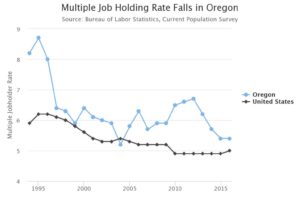Oregon’s Multiple Jobholders in 2016
Oregon Workforce and Economic Information
In 2016, 106,000 Oregonians held more than one job in addition to their primary job and were considered to be multiple jobholders. The multiple jobholding rate – the proportion of multiple jobholders among all employed workers – was 5.4 percent, which was slightly above the U.S. rate of 5.0 percent.
Multiple jobholding has generally become rarer in Oregon and the U.S. since 1995. Research shows that people are less likely to take on a second job than they were in the past. Oregon workers were more likely to hold more than one job at a time than our national counterparts, a trend dating back at least two decades. Oregon’s multiple jobholding rate has been higher than the U.S. every year since 1994, with the brief exception of 2004. The U.S. multiple jobholding rate stabilized at 4.9 percent from 2010 to 2015, before increasing slightly to 5.0 percent in 2016. Oregon’s rate climbed from 2009 through 2012 before falling to 5.4 percent in 2016.
Economic conditions certainly affect whether or not an individual works more than one job, but there is no clear association between the multiple jobholding rate and the business cycle. That is because fewer jobs are available during recessions, right when more people need a second job to help meet their expenses. During expansions, increased income and looser credit constraints mean fewer people need a second job to meet expenses. These factors seem to cancel each other out on the whole, which is why multiple jobholding rates don’t rise or fall significantly with the business cycle.
Disclaimer: Articles featured on Oregon Report are the creation, responsibility and opinion of the authoring individual or organization which is featured at the top of every article.



